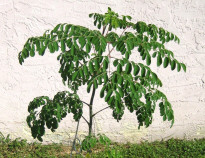You can keep the seeds in plastic
zip bags, or in
paper bags.
Supposedly, Moringa seeds are viable when they are fresh from mature pods,
and up to three months after
harvest. However,
we have planted
Moringa seeds
that are several
years old - and,
they grow!
Generally, the germination rate
of Moringa seeds depends on how
they were stored,
and how they
were planted.
Moringa seeds
love to grow into
Moringa trees,
which do not need
to be pampered.
Because they are
a tropical tree,
remember to
store them at
room temperature,
where it is at least
above 60 degrees.
They prefer it much warmer than that, but will still grow if stored where it is
warm and dry.
Even though they
are a large seed,
compared to spinach or
carrots, they do
not need to be planted deeply
in the ground.
Plant them too deeply, and they will not sprout.
I Love Moringa
the fast-growing, nutritious, delicious gift from God
How to Plant Moringa Seeds
These planting instructions can be applied to all varieties of Moringa
seeds. One interesting thing about Moringa seeds, is that they can
be planted right into the ground, straight from the Moringa pods.
They do not need to "dry out" or "age", as do some seeds.
This page was last updated: August 28, 2022
"Hi! I'm Morey, the Moringa Oleifera Seed!
PLEASE do not put me in your
refrigerator, or in your freezer! I am the
seed of a tropical tree, and I will die!"
There are many ways to plant Moringa seeds. Some Moringa growers soak the seeds for a few days, some plant them in pots, some sow them directly into the ground.
Our best results have come from starting them in small pots, in loose, organic potting soil that has some coconut coir mixed in with it, but they sprout well in many soils.
Plant them about 3/4 to 1 inch deep, and tamp the soil down on top of them loosely. They do not like compacted soil.
Then, water them thoroughly, put them in a warm place with as much light as possible, and wait. You can give them a
little water every day, until they sprout - then, every other day, water until the soil on top is moist. Too much water - they will drown!
Once they are about 8 inches tall, we plant them right into the ground or transfer them into larger pots. You can start them in Jiffy Peat Pellets, but peat does not provide enough nourishment for them to thrive.
If you use the Peat Pellets, transplant them into larger pots filled with potting soil, when they are about 3 inches tall - Jiffy Peat Pellet, and all!
Above, we mentioned soaking the seeds. If you do, please be prepared - they develop a strong, unusual, unpleasant odor. We usually plant ours right into the potting mix or into the ground, but soaked seeds are fine - just remember to use the water they soaked in, when you are planting them.
They do not care for clay, vermiculite, heavily compacted soil, or peat pots. Perlite mixed into the organic potting soil, or your own loose soil, is fine, but they simply detest vermiculite. Peat pots are pots that are made of dried, compressed peat moss. We did not have good results with our seeds that were planted in them. They sprouted just fine, but did not like to grow in them, despite the organic soil we had in the pots.
The Jiffy Peat Pellets are fine for sprouting them, but peat pots dry out too fast for Moringa seedlings. If that is all you have to use, you will have to keep a close watch on them,
so they do not dry out.
If you intend to start them right in the ground, please remember that Moringas are considered to be a tropical tree, and they require sunlight, warmth, and some water
to grow properly.
Once they are firmly established, with “woody” trunks, Moringas can withstand drought-like conditions - but, they need the 3 items underlined above, to get off to a good start.
Moringa seeds prefer to sprout in temperatures that are between 70° and 90°F. Be sure to plant your seeds when the weather is warm, as they will simply thrive, if they are able to be outside, in the warm sunshine. No matter how you plant them, always allow for good drainage, as their roots will rot in soggy soil.
Within 2 weeks of planting your Moringa seeds, you should have seedlings up, sporting healthy, green leaves. Once they put out some distinct branches, water them only once or twice a week.
They do not like their roots to be standing in wet soil, so be sure they have good drainage. We cannot stress that, enough.
When they are about 8 to 10 inches tall, we start
to harvest a few leaves from each seedling, by cutting the branches in half, which encourages them to "bush" out.
Not too much water, lots of warmth, occasional organic fertilization, some water, and your Moringa seeds will sprout, and grow into lovely, valuable Moringa trees!
P.S. We have planted seeds that are several years old - and they grow - but most people say that the seeds are only viable for about 3 months. That has not been our experience, and we have planted thousands and thousands of Moringa seeds!
HOW TO:
More About --- Moringa
